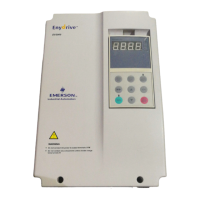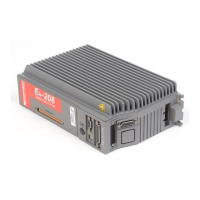Safety
information
Product
information
Mechanical
installation
Electrical
installation
Getting
started
User Menu A
Commissioning
Advanced
Parameters
Diagnostics Optimization CT MODBUS RTU Technical Data
174 E300 Design Guide
Issue Number: 1
7.16 Inertia compensation
Inertia compensation compensates for the elevator inertia acceleration torque), and for the elevator car load holding torque). This information is then
used to apply a torque reference to enable good ride comfort when starting the elevator. This is achieved by adding the torque reference to match the
weight of passengers in the elevator and the accelerating torque for the inertia of the elevator car when opening the mechanical brake.
This data can then be used to overcome the mechanical inertia of the elevator system. Implementing inertia compensation gives a dynamic torque
feed forward based upon the inertia of the system and the acceleration rate used, reducing the work done by the speed loop i.e. it reduces speed loop
error.
Table 7-31 Inertia compensation parameters
The scaling to modify the acceleration feed forward to accommodate the system inertia may be calculated from
A = Inertia compensation scaling
B = Inertia of the system in kg m
2
C = Rated motor torque in Nm
D = Gear ratio numerator / Gear ratio denominator
E = Radius of the sheave
A = 1000 x B x D / (C x E)
Inertia compensation is not active during an autotune.
7.17 Simulated encoder output
The E300 Advanced Elevator drive has a simulated encoder output available when operating in Closed loop operating modes which is generated
from the drive’s main position feedback at a default ratio of 1:1. The simulated encoder output (AB only) as default is derived through hardware from
the main position feedback connected to the drive’s encoder interface. Simulated encoder output is not available in Open-Loop.
Table 7-32 Encoder output options
Encoder Simulation Status (C29) will display the hardware simulated encoder output which is available based upon the main position feedback device
set-up on the drive.
The hardware simulated encoder output (AB only) from default is derived through hardware, Encoder Simulation Mode (C31) = 0 with an update rate
of 250 μs. Additional modes of simulated encoder outputs are also available.
Table 7-33 Hardware simulated encoder output
Parameter Description
Inertia Compensation Enable (E10) Enables the inertia compensation torque offset to be applied.
Inertia Compensation Total Inertia (E15)
The total inertia is used in combination with Inertia compensation reference acceleration to derive the
torque required for acceleration.
Torque Per Amp (E16) This is used to scale the acceleration torque into percentage of system rated torque
Inertia Compensation Torque (E17) Allows the load cell feedback to be zeroed for a balanced elevator car.
Inertia Compensation Acceleration (E18)
The profile generator acceleration output used in combination with Inertia compensation total inertia to
derive the torque required for acceleration
Main position feedback Simulated encoder output
AB.Servo, FD.Servo, FR.Servo, SC.Servo, SC.SC, Commutation only No simulated encoder output available
AB, FD, FR, SC, Resolver, SC.Hiperface Full simulated encoder output available
SC.EnDat, SC.SSI Simulated encoder output available, no Z marker pulse available
EnDat, BiSS, SSI Full simulated encoder output available
Parameter Detail
Encoder Simulation Status (C29)
Displays the simulated encoder output available based upon the position feedback connected to and
configured in the drive.
Encoder Simulation Mode (C31) 0: Hardware 1: Lines per rev 2: Ratio 3: SSI
Encoder Simulation Hardware Divider
(C32)
Defines the ratio between the main position feedback device and the simulated encoder output in Hardware
mode.
Encoder Simulation Hardware Marker
Lock (C33)
Marker output is generated from the marker input. Alternatively the marker output can be locked where both
AB, FD or FR are high.

